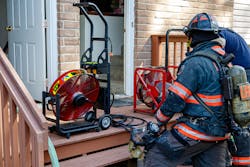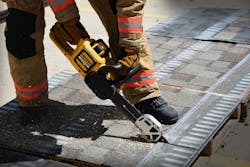There is something missing from the array of sounds that are found at many emergency scenes: the loud whirring of a gasoline-powered hydraulic unit and the buzzing of chainsaws and circular saws as they sit in idle.
Enter battery-powered rescue equipment. Quiet, yes, but also efficient and effective. The fire service has seen its fair share of change over the past decade, but perhaps the most significant improvement to date is the advent of the contribution of the lithium-ion battery to emergency operations.
Battery-powered rescue equipment and tools aren’t new per se, but their implementation increased dramatically recently.
From extrication tools, including cutters, spreaders, rams and combination tools, to smoke ejectors, from chainsaws, reciprocating saws and circular saws to lighting, it seems that battery power has gone from fringe to trustworthy to go-to for firefighting and rescue equipment.
Firehouse Magazine spoke with industry leaders in rescue equipment and the first responders who use the tools to get a learn more about the latest battery-powered innovations and how the products that incorporate them are better than the models that preceded them just 5–10 years ago.
Mike Canon, who is the director of rescue sales for IDEX Fire & Safety, which includes HURST Jaws of Life, says that the best that you could get in a 2-pound battery 10 years ago was 2.6 amps, which only delivered 15–20 cuts per battery charge. Now, batteries deliver as much as 9 amps, to permit 54 cuts in high-strength steels that are used in automobiles. What if you told Canon 10 years ago that such battery-powered performance would be the case today? “I would have laughed at you,” he says.
Canon says that innovation and invention are the products of necessity for the HURST line, because safe and efficient patient packaging is the company’s No. 1 goal. “Any design feature that serves that end, those are the design elements that we pursue,” Canon states.
The Smart Dashboard display for real-time tool status, including battery operation, on HURST’s eDRAULIC 3.0 extrication tool line is said to increase speed and to provide the industry’s first patented watertight design for fresh and saltwater compatibility.
“Making the tool underwater-operable will completely change the game,” Canon says. “Working on automobiles in ditches and culverts and USAR applications, with an increase in natural disasters, you will see them in house-to-house and room-by-room searches.”
Joel Meeter, who is assistant chief of training with Livermore, CO, Volunteer Fire Protection District, says his department recently received a grant to purchase several HURST eDRAULIC extrication tools. His department covers 300 square miles north of Fort Collins to the Wyoming border, including a high-speed state route that has seen its fair share of motor vehicle collisions that were caused by unpredictable mountain weather. Meeter says that he and his crewmates often must carry equipment a substantial distance down brushy hills on scene of these automobile accidents. “Not having to carry a power unit, hose and tool, just carrying the hose, is a lot easier.”
Meeter recounted one emergency scene where a gasoline-powered unit was off camber and shut off, because the oil reservoir indicated that it was low as a result of the pump’s position on the hill.
The Smart Dashboard provides the first responder with live, visual and easy-to-see tool feedback in three key areas: roll warnings, which assist operators with cutter positioning; power level indicator, which alerts operators to real-time power level, so they can reposition the tool for another cut; and a battery charge status indicator, which ensures that operators are aware of runtime in real time.
“By bringing electronics to the game, we can give the user critical information when they need it most,” Canon says. “Blind cuts are the single most common time to have catastrophic failure on the cutters. This gives [first responders] what they need to know in the moment they need it.”
Canon dismisses the idea that the heavier and longer battery-powered extrication tools tend to make maneuverability more difficult. (HURST’s battery-powered E3 cutter is nine pounds heavier and four inches longer than the company’s S 788 hydraulic model.) He tells Firehouse Magazine that it simply is a matter of training. “If you can think of one way to [complete a task], you really should have three to four other options ready to complete that task.”
Reducing stress
Grand Rapids, MI, Fire Department Firefighter/Equipment Operator Dan Weatherwax, who is a member of Rescue 2, says his department’s use of battery-powered tools and equipment is driven by technical rescue, including confined space.
“It’s nice to be able to work without generators, cords and gasoline, especially in a confined space,” Weatherwax explains. “The exhaust [from the gasoline-powered tools] may make more of an atmospheric issue for us. All around, [battery-powered tools] are just easy to use.”
Battery-powered tools’ ease of use also can bring down the level of stress for responders on an emergency scene: With a flip of a switch, the tool is in operation. Memphis, TN, Fire Department Firefighter/Paramedic Jason Nichols agrees, stating that the advantages outweigh the disadvantages when it comes to battery-powered equipment—although he concedes that the limitation of battery life is undeniable. “Both the chainsaw and DeWalt saw are easy to run up a ladder in no time. No cords or gasoline powerplants needed. These saws require very little maintenance and start every time,” Nichols explains.
Kevin Sears, who is territory manager and factory representative with Genesis Rescue Systems, believes that battery-powered extrication tools contribute to “calming the extrication scene” by reducing possible first responder anxiety and eliminating the need to yell over a running gasoline-powered generator.
Additionally, Sears says battery-powered tools inherently reduce the setup time on a rescue scene. They do this by eliminating the need to carry the power unit and hoses.
Genesis Rescue Systems boasts a brushless motor technology that’s said to help to reduce heat and to increase battery life on its complement of EFORCE SL3 extrication tools, including cutters, spreaders, rams (both push-pull and telescoping types) and combination tools.
Genesis’ S54-SL3 EFORCE Spreader, which is the largest that’s in its lineup, has a spreading distance of 32 inches. Recently redesigned, the tool’s smaller, more efficient brushless motor allowed the company to reduce the weight of the tool to 46 pounds compared with the 53 pounds of the previous 32-inch spreader.
Weatherwax affirmed the battery-powered tool’s capability to “hang” with its hydraulic counterparts. He explains that in a recent technical rescue class, the battery-powered tools were every bit as reliable and powerful in carrying out tasks as the hydraulic units were.
Firefighters generally are hesitant at first, “but once they test it out, you’re starting to see a lot more believers than naysayers,” Weatherwax says.
At a recent commercial fire, Nichols says that a DeWalt mini K12 saw, which runs on a 60V battery, was used to cut a 60-foot section of plywood along a parapet. Nichols says the tool never lost power. “They [battery-powered tools] are almost our go-to right now, because they are that fast and easy,” Nichols says.
According to DeWalt, the FlexVolt 60V MAX Cordless Brushless Cut-Off Saw that’s used by Nichols makes cuts as deep as 3¼ inches. It enables fast and efficient single-pass cuts and scores in concrete, pavestones, steel and rebar. A rotatable, five-position guard allows selection of approach angle for optimal visibility and accessibility when cutting in tight spaces. The saw can cut in both horizontal and vertical positions. In addition, a new heavy-load indicator light provides the user with power and runtime feedback.
Most of the battery-powered tools that are on the market aren’t using proprietary batteries but instead use DeWalt’s, Milwaukee’s and other brands’ batteries. So, essentially, replacement is as easy as visiting a home improvement retailer.
Variability, versatility and compatibility are characteristics that Super Vac President Roger Weinmeister says make his ventilation equipment the most compatible interface on the market.
Super Vac says that its battery-powered fan lineup includes the only PPV fans in the firefighting industry that work with other battery-powered tools. Super Vac’s 16-, 18- and 20-inch variable-speed battery-powered fans work with DeWalt, HURST and Milwaukee batteries.
The V20-BH 20-inch ventilation fan is powered by the same IP66-rated batteries that power HURST eDRAULIC 3.0 Watertight Extrication Tools. The IP66 rating certifies the fan’s capability to protect against exposure to water.
Available with both 5.0Ah or 9.0Ah batteries, as well as 120/240V a.c. shore power, the fan is said to deliver 12,550 cfm output and as much as 60 minutes of run time when it is operating on maximum airflow, depending on battery selection.
Super Vac says the V20-BH is the only battery-powered ventilation fan of its size in the industry, weighing in at 61 lbs., with a 28¼ x 28¼ x 12½-inch footprint.
“Our claim to fame in ventilation land is plan around existing batteries out there,” Weinmeister tells Firehouse Magazine. “Our view is, if you have something that you can use in multiple spaces, you can plug into the other equipment.”
Weinmeister believes that the many benefits of battery-powered equipment, which include reduced noise, space saving and ease of operation, have inspired some large city departments, including Chicago and San Francisco, to go all battery in conjunction with their municipal environmental stewardship initiatives.
“A lot of people are trying to do their part,” Weinmeister says.
To that end, California Gov. Gavin Newsom recently signed legislation to ban small gasoline-powered engines, including those that are used in lawn and garden equipment, such as chainsaws, in the state by 2024, although it’s unclear whether fire departments are included in the regulation.
Nevertheless, firefighters, including Weatherwax, see the writing on the wall.
“Gasoline-powered equipment is fossil technology, and it’s not going to be around forever,” Weatherwax says.
With all of the benefits of battery power, are there any limitations to the technology?
The biggest drawback that was mentioned by Firefighters Weatherwax, Meeter and Nichols is battery life.
“You have to have a way to keep the batteries charged,” Weatherwax says. “A lot of departments might be integrating the chargers into the apparatus, but we don’t. Our charger is not part of the rig.”
When the number of batteries that a rig carries is finite, a prolonged incident at which battery-powered rescue equipment is used could pose challenges.
Getting firefighters on board with battery power can be a difficult endeavor. That’s why companies, including DeWalt, Genesis, HURST and Super Vac, work continually to improve previous models.
So, it likely is just a matter of time before “time” no longer is a limitation but rather a benefit of battery-powered tools.
Nichols points out that sourcing batteries for discontinued or aging equipment could be challenging as well.
Despite any reservations about battery-powered tools and equipment versus traditional corded models, at the Memphis Fire Department, it was the field personnel themselves who initiated their organization’s move toward the new technology.
“In general, if we can get something that is going to make our job better, faster and more efficient, it’s a good thing,” Nichols says. “When you talk about a new tool [on the apparatus floor], everyone gathers around to see how it runs, works and operates,” he states further.
Whether it’s in regard to time or temperature, companies are working continually with their research and development departments to best their previous-generation tool or battery offering.
Canon mentions that the batteries for HURST’s equipment can tolerate temperatures that exceed 120 degrees Fahrenheit. “Take a hot July day in Texas: It isn’t unrealistic to see the battery reach 104 degrees in relatively short order. The HURST battery can tolerate up to 131 degrees before it has to shut off for self-preservation,” Canon says.
When it comes to the ease of operation and the versatility of firefighting and rescue tools and equipment, industry insiders agree, hydraulics and corded tools might one day be a distant memory.
“My prediction is hose-line tools will go extinct in terms of sales in 5–10 years,” Canon says.” In many ways [battery-powered tools] are safer on the rig, not to mention more versatile and capable.”

Kristen Wade
Kristen Wade is a battalion chief and EMS program manager with the Sugar Grove, IL, Fire Protection District and is in charge of an engine and ambulance company. She has nearly two decades of experience in the fire service and 15 years of experience as an Illinois licensed paramedic. Wade served as an instructor for the Illinois Fire Service Institute’s fire officer program. She is certified by Illinois Firefighter Peer Support. The organization focuses on the mental health and wellness of EMS and fire personnel. She obtained a bachelor’s degree in English communications from Fort Lewis College.










